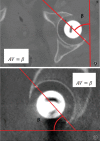Non-equivalent Results from Different Anteversion Measurements Methods for the Evaluation of the Acetabular Cup Orientation in Total Hip Arthroplasty
- PMID: 30932341
- PMCID: PMC6594505
- DOI: 10.1111/os.12445
Non-equivalent Results from Different Anteversion Measurements Methods for the Evaluation of the Acetabular Cup Orientation in Total Hip Arthroplasty
Abstract
Objective: To determine the comparability among 10 radiographic anteversion methods for acetabular cup orientation in total hip arthroplasty (THA) found in the literature and the "gold" standard of assessing the anteversion with CT.
Methods: This is a retrospective study that blindly compares 10 different conventional radiographic anteversion measurements with the "gold" standard, the measurement of anteversion on the transverse plane of the 3-D images made with CT. The patient archiving and communications system (PACS) was systematically searched for subjects that had undergone a CT angiogram of the abdomen and lower extremities, including the pelvis, had at least one THA in situ and had undergone anterior-posterior (AP) and cross-lateral pelvic radiography between January 2013 and August 2016 in the Diakonessenhuis Hospital Utrecht/Zeist, a non-academic institution. CT scans of patients (n = 16) were systematically collected. Three observers independently measured cup anteversion from radiographs, using a total of 10 different methods, and measured the "gold" standard on CT images. The outcomes of the 10 radiographic anteversion were compared in terms of linear correlation with the "gold" standard on CT images.
Results: The correlations of the radiographic measured anteversions with the "gold" standard measured on CT images were 0.528 for the method of Liaw, 0.556 for Wan, 0.562 for the cross-lateral method, 0.586 for Hassan, 0.594 for Dorr, 0.602 for Lewinnek, 0.624 for Widmer, 0.671 for the lateral CT, 0.747 for Ackland, and 0.771 for the method of Riten Pradham.
Conclusion: Anteversion measurement methods represent different projectional angles of the acetabular cup in different planes around different axes. Therefore, they differ from the "gold" standard and are not interchangeable, as is shown by this study. We consider the anatomical anteversion in the transverse plane rotating around the longitudinal axis as the "gold" standard and recommend avoiding using the term anteversion for other projectional angles in different planes.
Keywords: Acetabular cup; Anteversion; Orientation; Total hip arthroplasty.
© 2019 The Authors. Orthopaedic Surgery published by Chinese Orthopaedic Association and John Wiley & Sons Australia, Ltd.
Figures





References
-
- Lewinnek GE, Lewis JL, Tarr R, Compere CL, Zimmerman JR. Dislocations after total hip‐replacement arthroplasties. J Bone Joint Surg Am, 1978, 60: 217–220. - PubMed
-
- Fujishiro T, Hiranaka T, Hashimoto S, et al. The effect of acetabular and femoral component version on dislocation in primary total hip arthroplasty. Int Orthop, 2016, 40: 697–702. - PubMed
-
- Hassan DM, Johnston GH, Dust WN, Watson G, Dolovich AT. Accuracy of intraoperative assessment of acetabular prosthesis placement. J Arthroplasty, 1998, 13: 80–84. - PubMed
-
- Del Schutte H, Lipman AJ, Bannar SM, Livermore JT, Ilstrup D, Morrey BF. Effects of acetabular abduction on cup wear rates in total hip arthroplasty. J Arthroplasty, 1998, 13: 621–626. - PubMed
-
- Kennedy JG, Rogers WB, Soffe KE, Sullivan RJ, Griffen DG, Sheehan LJ. Effect of acetabular component orientation on recurrent dislocation, pelvic osteolysis, polyethylene wear, and component migration. J Arthroplasty, 1998, 13: 530–534. - PubMed
MeSH terms
Grants and funding
LinkOut - more resources
Full Text Sources
Medical

